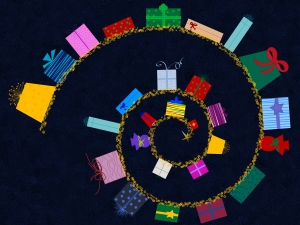 By Elisa Llamido, a producer, actress and writer and the creator of “The Perfect Pregnancy Workout vol. 3: The Ancient Art of Belly Dance for Labor,” living in Orlando, Florida, USA, with her husband, 19-year-old stepson, 5-year-old son and four frogs
By Elisa Llamido, a producer, actress and writer and the creator of “The Perfect Pregnancy Workout vol. 3: The Ancient Art of Belly Dance for Labor,” living in Orlando, Florida, USA, with her husband, 19-year-old stepson, 5-year-old son and four frogs
My 5-year-old son and I were on our way in to the grocery store when I suddenly realized that he wasn’t beside me. I turned back to see him standing on the sidewalk transfixed, staring at the scene unfolding before him.
A mother had been calling to her toddler to come out of the store, but he didn’t want to come. There was a large scale inside of the door, and he liked climbing on it and seeing the numbers move. There was clearly a difference in priorities here.
What caught my son’s attention was her closing gambit: “You’re not coming? OK, BYE!” She turned and walked out without him. The little boy quickly dropped what he was doing and ran after her, terrified of losing her.
My son, Jason, couldn’t take his eyes off of the scene. His horrified expression made his face a frozen mask.
“Why did she say, ‘Bye!’?” he asked.
I tried to explain it away. “She probably has somewhere that she needs to go and she doesn’t want to wait anymore,” I told him.
I realized that this me-centric explanation wouldn’t be enough for my kid. “She doesn’t really want to leave him, but she said this because she wants him to come now,” I said. Since one of the things that we work on in our house is not doing things to try to manipulate others, that sounded even worse. I grasped wildly for an explanation that would mollify my son, but I came up with nothing. We both stood, watching and waiting for the rest of the drama to unfold.
We didn’t have to wait long. The boy ran out of the store to the sidewalk, where his mother grabbed him by the upper arm and attempted to pull him so he would walk to the car faster. The toddler promptly sat down on the ground, in a last effort of defiance. Now the mother pulled harder, yanking him to his feet and dragging him, stumbling to the car.
I heard crying. It wasn’t coming from the stumbling boy. There was another witness to the scene, another towheaded moppet who was watching as the pair made its way through the parking lot. I glanced from Jason to the previously unseen witness. Wow, they’re really upset.
After they walked away, Jason suddenly reanimated and started walking into the store again, but this time he had a million questions. Why did she say that? Why did she do that? Did she hurt him? Why was she so mean to him? Was she his Mommy?
I realized that to Jason, and likely to the other little witness, this scene made absolutely no sense. They put themselves in the other boy’s shoes and couldn’t see any reason why the person who was supposed to love and care for him suddenly turned mean.
I confess that I could easily relate to why the mother did what she did. It had probably been a long day, she had probably run into the store for one forgotten item that she needed to make dinner and she just didn’t have time to wait for lollygagging. Add that to any sleep deprivation that many parents experience, and I think any adult could understand what she was feeling.
But not the kids.
Little children are gifted with the joy of living completely in the moment. They don’t understand deadlines and schedules, and their birthday or winter holiday is an eternity away. Time doesn’t mean anything. So when passing by a scale, there’s really no reason why they shouldn’t climb on it. They’re here, and there’s a scale that has a hand that moves up and down when you jump on the plate. If you asked them, they’d tell you that they couldn’t understand why you wouldn’t stop to check it out, even though you have to get home to make dinner. They may never get the chance to play on this scale again.
It’s a question of priorities.
When I’m able to adopt my son’s outlook, I feel much happier. This week, I stopped on my way into a store to snap a photo of a double rainbow on my phone and then stood and looked at it a moment, savoring it, knowing that in a minute it would be gone forever.
Before becoming a parent, I was so caught up in trying to get ahead that I dismissed anything done just for pleasure as frivolous. One of my son’s many gifts to me is that he makes me stop in my break-neck pace of deadlines and stress to look at a bug or see a bird in the yard. I realize that it’s important to stop and take in the beauty of these everyday miracles, including the miracle of the big scale at the supermarket exit.
At the same time, we adults do live in a world of schedules and we need to find a way to balance this while taking our kids’ priorities into consideration so that we can create a win-win situation where both sides feel like they get what they need.
Instead of going head-to-head with her son, the hurried mom could have spent the extra minute that she spent dragging him through the parking lot making a compromise: “We’ve got to get home to make dinner, sweetheart, so 10 more jumps on the scale and then it’s time to go.” She could then count backward as he jumped so that he’d know when his time was up. That way, he’d feel as though he was allowed to do something that he wanted, even if it wasn’t as long as he wanted to do it.
Or, if she was really in a hurry, she could have offered something more fun than the scale.
I am an athletic mom, so it’s always been easy for me to squat down, show my son my back and offer a ride. “The Mommy Train is leaving the station!” I’d call out when my son was younger, then make a door closing “Rheeeee!’ sound. My son could never resist, and he’d run over to jump on my back for a quick ride to the car. Or, if he didn’t jump on, I could scoop him up making big sound effects and then swing him around — with more sound effects, of course — as I carried him off, laughing. Now that he’s older, I can usually tempt him with a race to the car.
My friend, Cynthia, has a bad back and can’t carry her daughter, so she came up with her own invention of getting her little girl moving. Her daughter was captivated watching a marching band once, so now when she needs her to move quickly, she calls out, “OK, it’s time to march! Let’s march! Let’s march!” and her daughter quickly forgets everything else in her haste to fall in line and march after her mom.
Before I became a mother I was apprehensive about parent-child conflict. I’d seen so many of these confrontations in public places, and I didn’t want to have anything to do with them. My mom gave me her advice: “An adult should always be able to outsmart a child. We have experience. We have fully formed brains. If you can’t find a way to get a child to do what they need to do happily, you need to try harder.”
Does that mean that kids will always be reasonable? No, of course not. There are some times when they want something that they just can’t have.
My son used to want to operate heavy construction machinery. It’s just not possible, and he would get very upset. At those times, I would hold him close as he cried and let him know that I understood his frustration: “I know, honey. It would be so cool to push the levers on that truck! I want to do it, too! But we can’t. It’s not our truck.” He would cry for a moment, and then it would be over. He knew that I understood him.
I glanced at him now as we walked. His eyes were toward me now, looking for answers. I told him the truth as I saw it: “That Mommy was probably tired. She needed to get home soon and was in a hurry, so she tried to get him to leave. When he didn’t want to go, she grabbed him and made him go.”
Jason’s eyes were fixed on me now, riveted. I was confirming the horror that he thought he saw. And then I added, “I don’t agree with the way that she did that, and I would never do that to you.”
“I know, Mommy,” he answered. I then asked him, “What did you think of what you saw?” and he replied, “I don’t think she should have done that.”
Questions answered, his eyes left my face and he went back to his normal mode, contentedly observing the world around him and looking for exciting things to explore. I touched his shoulder in a gesture to satisfy my need for closeness after talking about something that disturbed him.
I wondered if that mom and son had resolved their differences as they got to the car. I hoped so.
 I feel a lot of love in my house.
I feel a lot of love in my house.







